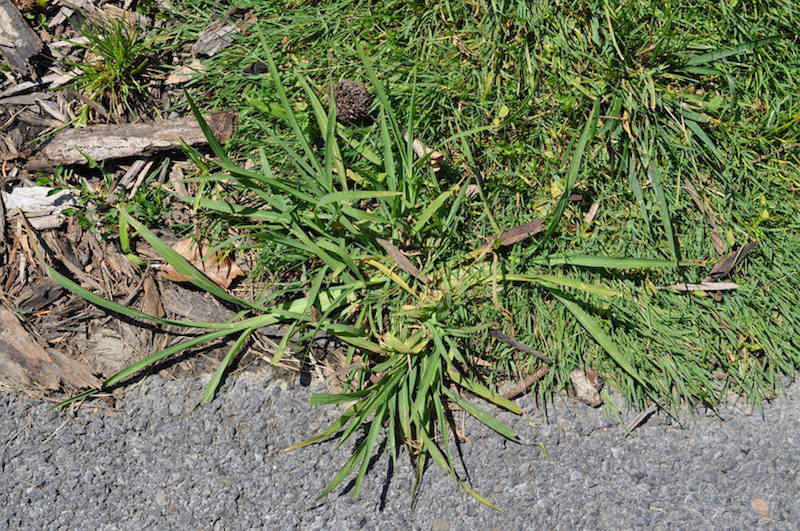
Once crabgrass gets started in your lawn, those coarse, unattractive weeds seem to live and spread forever. But unlike lawn weeds that do live several years, crabgrass plants only live a single year. What they do in that year, however, has long-lasting consequences for your lawn. Understanding how crabgrass works and how to break its cycle can help you get rid of crabgrass and keep it gone.
- Understanding the Crabgrass Cycle
- Preventing Crabgrass Plants
- Timing Crabgrass Preventers
- Killing Existing Crabgrass Plants
UNDERSTANDING THE CRABGRASS CYCLE
Crabgrass is a warm-season annual that germinates, lives and dies all in the same year. But crabgrass problems don’t end with the growing season. While they live, each crabgrass plant produces up to 150,000 seeds. Those seeds stay behind, ready to germinate the following spring and start the cycle all over again. Seeds that don’t germinate right away can remain viable and stick around to germinate in future years.
Once crabgrass seeds germinate and plants emerge, mowing your lawn short won’t stop the seeds. With its low-growing, crab-like growth, crabgrass can set seed when cut as low as 1/2 inch tall1 — that’s much lower than recommended healthy mowing heights for any common lawn grass. Effective control requires preventing crabgrass seeds from ever becoming seed-producing plants.
Low-growing crabgrass seeds escape mowers.
PREVENTING CRABGRASS PLANTS
With hundreds of thousands of crabgrass seeds potentially waiting in your lawn, preventing their successful germination is essential. Crabgrass preventer products use what are known as “pre-emergent” herbicides, which target germinating seeds before new shoots can emerge from soil.
Pre-emergents work by inhibiting seed germination and root development so that seeds can’t become established plants. Highly effective preventers such as Pennington UltraGreen Crabgrass Preventer plus Fertilizer III 30-0-4 control crabgrass and other germinating broadleaf weeds. This premium product then continues preventing these weeds for up to five months, while it feeds your lawn grasses at the same time.
While crabgrass preventers target weed seeds, they can inhibit germination and establishment of lawn grass seed, too. Always follow label instructions regarding seeding and your specific preventer product. As a general rule, wait at least 60 days and at least two mowings before overseeding lawn areas where crabgrass preventer was used.
A single crabgrass plant can set up to 150,000 seeds in a season.
TIMING CRABGRASS PREVENTERS
Because crabgrass preventers only work before crabgrass seedlings emerge through the soil, timing applications right is critical to success. Preventers must be applied before crabgrass seed germinates. Crabgrass seeds can germinate from early spring until late summer when soil temperatures are right.
In spring, crabgrass starts germinating when soil temperatures warm to 55 degrees Fahrenheit for four to five days in a row. Most garden centers carry inexpensive soil thermometers that can help you track soil temps and time your preventer properly. If you live in northern climates, nature helps, too. Yellow-blooming forsythia shrubs reach full bloom at the same soil temperatures that signal crabgrass germination.
Once soil temperatures warm and germination starts, crabgrass seeds continue germinating until soil temperatures exceed 90 F. While some preventer products stop working after a short window in spring, Pennington UltraGreen Crabgrass Preventer plus Fertilizer III 30-0-4 keeps on preventing crabgrass and other broadleaf weeds as it feeds your lawn through those crucial months.
KILLING EXISTING CRABGRASS PLANTS
Once seeds germinate and crabgrass sprouts emerge, pre-emergents no longer work. Then it’s time for “post-emergent” herbicides, which target plants instead of seeds. Crabgrass killers are designed to kill existing, actively growing crabgrass plants before they can produce more seed.
When using crabgrass killers or any herbicides, it’s important to understand whether the product is a “selective” or “non-selective” herbicide. Selective herbicides target specific weeds or plant categories, such as grassy plants versus broadleaf plants. Non-selective herbicides kill all plant types, including lawn grasses and other plants you want to keep.
Because crabgrass is a grass, most combination herbicide and lawn fertilizer products, known as weed & feed fertilizers, generally won’t kill it. These products typically include selective herbicides that kill broadleaf weeds, such as dandelions and other common lawn weeds, and keep grasses unharmed. Actively growing crabgrass in your lawn calls for selective, post-emergent herbicides, such as Image All-In-One Lawn Weed Killer or Image Herbicide Kills Crabgrass, that kill crabgrass and leave your lawn grass untouched.
Always read product labels carefully, and make sure the label lists your lawn grass type as approved. Some lawn grasses, such as centipede grass and St. Augustine grass, are susceptible to herbicides that don’t harm other lawn grasses. Whenever treating lawn weeds with herbicides or weed & feed fertilizers, follow label instructions thoroughly, including safety precautions to protect pets, kids and adults.
When crabgrass threatens to disrupt your lawn, you can take control, break the cycle and prevent its spread. Emerald Yards is committed to providing you with the finest in quality lawn and garden services along with expert advice to help you achieve the lush, healthy, weed-free lawn you desire.
